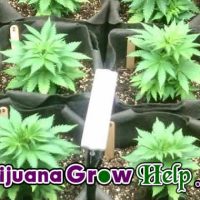Pots & Sizing: From Seedling to Harvest

Seedling
With all the focus on the actual body of your plant, it can be easy to forget about what’s going on beneath the surface of the soil. But your plants root system is an integral component, and you’ll want a healthy root bundle if you hope to grow the best indoor marijuana. You cant just let your seedling live it whole life in one container.
Once you’ve gotten past the seedling stage and you’re ready for serious vegetative growth, you have a few options. If you know how large your plants will be when they reach maturity, you can immediately plant them into their larger pots and leave them there for the entirety of the growth cycle, but there are benefits to repotting as your plant grows, too.
As a general rule of thumb, your plants should be in pots providing roughly one gallon per foot of height. So if you have a 3 foot tall plant, you’ll need a 3 gallon pot or container. Most growers will re-pot their plants 2 – 3 times before flowering.
When you repot your plants in preparation for flowering, be sure to take into consideration the extra growth your plant will have; some plants will double or triple in size during their flowering period. So if you have a 2 foot tall plant in a 2 gallon bucket, you’ll want to move it to a 3 – 5 gallon bucket before you start flowering, depending on how large you expect it to get.
As a general rule of thumb, consider the following:
- seedlings and young clones should start in a 1 gallon pot / bucket
- after 14 – 21 days in a 1 gallon bucket, re-pot seedlings to a 3 gallon bucket
- if necessary, re-pot again into 5 gallon pots at the start of your flowering cycle
An alternative for the experimental grower is to use an indoor bed in lieu of individual pots / containers. There are obviously advantages and disadvantages to this method of growing. First and foremost, the logistics of building an indoor bed may not be feasible for many growers.
Second, removing plants from an indoor bed can be more troublesome if you find that you have males or hermaphrodites among your crop midway through the growth. Third, if you end up with any problems in your soil, whether it’s bugs, pH issues, mold or root rot, those problems will spread quickly and could devastate your crop.
On the upside, a bed allows your plants more room to develop their roots. If you’re growing a sea of green (SOG) or a screen of green (SCROG), a bed might be a perfect addition to maximize the use of your limited space. Harvesting individual plants can also be trickier, though, so like many aspects of growing, it will ultimately be up to you to decide what’s best for you.





No comments yet.